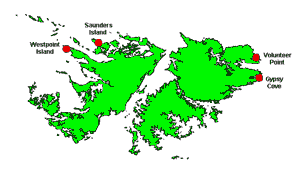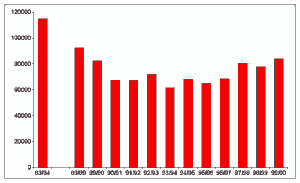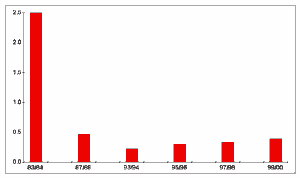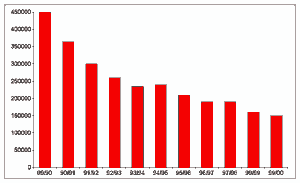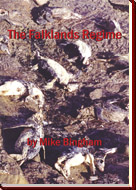 |
 |
| |
|
| Is tourism
damaging Falklands wildlife? by Dr Mike Bingham The Falklands are made up of more than 700 islands, with a total land area of 12,000 square kilometres, but they have a human population of less than 4,000 people (2,500 civilians and 1,500 military personnel). The Falklands may seem an unlikely destination for ecotourism, but in fact they receive more than 30,000 tourists per year, and the numbers are growing. In 1984 the Falkland Islands had a total penguin population of 6 million. Sadly this has now been reduced to just 1 million as a result of over-fishing during the 1980s. The Rockhopper Penguin has been the worst affected, with numbers dropping from 2.5 million pairs in 1984 (Croxall et al. 1984) to just 297,000 pairs by 1996 (Bingham 1998). A decline of nearly 90% in 12 years. Despite these declines however, the Falkland Islands remain one of the world's most popular destinations for penguin spotters, and the affects of its growing tourist industry have been under study for the last 7 years. Although visitor presence may have short-term affects on penguins in terms of heart-rate and stress levels, it must be remembered that wild animals are subjected to certain levels of stress in their natural environment. It was therefore decided to monitor the affects of visitor presence in its wider perspective, by conducting long-term studies of population trends and chick-survival rates. Chick survival rates in particular provide a useful guide to the levels of visitor disturbance. Excessive visitor disturbance during the
breeding season can affect penguins in a number of ways. These potential consequences of disturbance (and possibly others) should be apparent from reduced breeding success, and possibly population changes also, if such disturbances occur at a significant level. Studies have been conducted since 1993 to examine these parameters, both for sites which have visitors and for those which do not. TYPES OF TOURISM The way in which tourism can impact on penguins varies considerably from site to site, depending upon the types of visitors. Throughout the summer season (November to February) moderate numbers of tourists visit the Falkland Islands via commercial flights from South America and the United Kingdom. These visitors, combined with local residents and military personnel based in the Falklands, travel to penguin colonies around the Falklands in small groups. A number of settlements have established tourist facilities to deal with these visitors, some offering accommodation, and others just access to the penguin colonies. The average number of visitors present at these sites at any one time is fairly small, but visitors are present around the penguins on a daily basis, and the visitors are often unsupervised. By contrast, the majority of the tourists who visit the Falklands each year come on cruise liners. These vessels often hold several hundred passengers, but generally visit for just a few hours. These passengers mostly want to see the penguins, and a few settlements have established facilities to deal with these vessels. Penguin colonies at these sites will have a hundred or more visitors wandering around the colony at one time, but such parties are generally well supervised by cruise vessel staff. These colonies do not receive visitors on a daily basis, and may go for weeks between visits. In addition to differences in visitors and site conditions, there are also differences between the species which affect their susceptibility to disturbance. King, Gentoo and Rockhopper penguins all nest above ground, whilst Magellanic Penguins live below ground in burrows, which can easily collapse if people walk over them, killing eggs, chicks and even adults. King Penguins do not make nests, but instead
carry the single egg or chick on their feet, making them susceptible
to over-enthusiastic photographers. Gentoo Penguins nest in colonies,
but will easily abandon their nests if visitors approach too close,
leaving the eggs or chicks vulnerable to predation from skuas and
other aerial predators. Rockhopper Penguins are more aggressive,
and are not so easily disturbed unless people try to walk amongst
the colony.
STUDYING THE EFFECTS In order to determine the impacts of these different types of tourism, it was necessary to monitor a number of different sites, and to provide controls at each site so that penguins which received no visitors could be studied for comparison. The sites selected were: Volunteer Point: This is the most
popular tourist destination in the Falklands, because it is the
only site to hold large numbers of King Penguins. There are also
large numbers of Gentoo and Magellanic Penguins present. The site
is accessed by a track that requires an all-terrain vehicle, so
most overseas tourists visit the site using local tour operators
who take the visitors to the site and act as guides. This does provide
some control over visitor behaviour, although large numbers of local
residents and military personnel do visit the site unsupervised.
Saunders Island: No other site in
the Falklands offers such a variety of wildlife at one location,
with all the Falkland penguins being found along a 2 kilometre stretch
of coastline. Small numbers of visitors are present daily throughout
the breeding season, and these people use self-catering accommodation
which is provided close by. Visitors are free to visit the penguins
at their leisure, and most visitors are unsupervised. Westpoint Island: Westpoint Island
caters for cruise vessels rather than visitors who come to the Falklands
on commercial flights, and the penguins and albatross at the Devil's
Nose are the main attraction. These colonies go for days or weeks
without visitors, and are then exposed to a hundred or more visitors
within just a few hours, when a cruise vessel visits. Visitors are
generally well supervised by cruise vessel staff, who ensure that
disturbance is kept to a minimum. Gypsy Cove: Gypsy Cove is the nearest
penguin colony to Stanley, the Falklands capitol. As such it receives
large numbers of visitors of all types, and a surfaced road has
recently been laid to the site to aid access. BREEDING SUCCESS Throughout the period of study (1993 to 2000) there were no major differences in breeding success between colonies receiving visitors and colonies not receiving visitors. This was true for individual sites and years as well as for the overall averages. Taken species by species the mean results were as follows: GENTOO PENGUIN: ROCKHOPPER PENGUIN: MAGELLANIC PENGUIN: BLACK-BROWED ALBATROSS: KING CORMORANTS: POPULATION CHANGES During the period of study a number of external factors have influenced the population trends of seabird breeding sites throughout the Falklands. During the 1980s over-fishing led to large scale population declines amongst Falklands penguins and other seabirds. During the 1990s however, better regulation and reduced fishing effort has led to a partial recovery of Gentoo and Rockhopper penguins, although populations are still well below their 1984 levels. Magellanic Penguins and King Cormorants have continued to decline throughout the 1990s however, perhaps due to a greater sensitivity to the levels of commercial fishing which still continue around the Falklands. Comparisons of sites with visitors and those without visitors must be considered against these background population trends, with the focus being on the differences between the two, rather than the individual results themselves. Graphs showing these background population trends are included for each of the penguin species. The results are as follows: GENTOO PENGUIN:
ROCKHOPPER PENGUIN:
MAGELLANIC PENGUIN:
BLACK-BROWED ALBATROSS: KING CORMORANT: SUMMARY There are no major differences evident in the breeding success rates of penguins, albatross or cormorants which receive visitors and those which do not. Some tiny differences are apparent in favour of colonies receiving visitors, but such differences are very small and not statistically proven when one considers the natural variation of such studies. Gentoo Penguins, Rockhopper Penguins and Black-browed Albatross have all shown background population increases during the period of study, but there are no apparent differences between colonies which receive visitors and those which do not. Magellanic Penguins and King Cormorants have both shown significant background declines during the period of study, but the results suggest that colonies which receive visitors have declined by less than those which do not receive visitors. CONCLUSIONS There is no evidence to suggest that the present level of tourism has any detrimental effect on penguins, albatross or cormorants. In fact there is some suggestion that colonies which do have visitors may receive a small benefit, although these differences are in general not statistically proven, and cannot be considered conclusive. It is likely that in the short-term penguins and other seabirds will suffer from slightly raised levels of stress in the presence of visitors. We must however consider whether or not such instances of stress are significantly different from the normal stresses which such birds are subjected to by aerial predators and other natural factors. The results would seem to suggest that in general they are not. If the very small positive influence of visitors on breeding success and population trends suggested by the results is genuine, and not just natural variation, then it suggests that visitors may have a small impact on other areas of the ecology. The possibility that visitors are having a disturbing influence on aerial predators, such as skuas, cannot be ruled out. In conclusion, it would appear that the present level of ecotourism in the Falklands is not having any significant detrimental effect on the species which the visitors come to see. In addition ecotourism undoubtedly has a number of beneficial consequences. It provides wildlife with a commercial value, and gives support for its protection within the commercial sector. It also educates and entertains the people who come to see the wildlife, raising awareness and gathering support for wildlife protection within the community as a whole. It will always be difficult to provide strong argument for wildlife protection unless people can relate to wildlife on a personal level. It is therefore important to promote ecotourism, whilst at the same time ensuring that such tourism does not damage the wildlife resources which people come to see. In the Falklands the impacts of tourism will continue to be monitored to ensure that this situation continues as we move into the 21st Century. ACKNOWLEDGEMENTS Many thanks to all the farmers who allow us to conduct research on their land to study the effects of tourism activities. In particular I would like to thank David and Suzan Pole-Evans, George and Jenny Smith and Roddy and Lily Napier. REFERENCES Bingham, M. - (1998) Penguins of South America and the Falkland Islands. Penguin Conservation, 11(1): 8-15. Croxall, J.P., McInnes, S.J. and Prince P.A. - (1984) The status and conservation of seabirds at the Falkland Islands. In Status and conservation of the world's seabirds, ICBP Technical Publication No.2, (ed. J.P. Croxall, P.G.H. Evans and R.W. Schreiber), 271-291, ICBP
|
|
|||||||||||||||||||||||||||||

